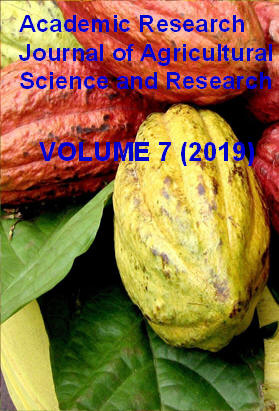|
ISSN: 2360-7874 |
Academic Research Journal of
Agricultural Science and Research |
|||||||||||||||||||
|
Vol. 7(6), pp. 359-363, September 2019 Research Evaluating the efficacy of pre-plant seed disinfection practices against seed bourn sorghum covered smut in Eastern Ethiopia
Tadeos Shiferaw*1, Fano Dargo2, AyantuTucho1
1College of Dry Land Agriculture, Department of Dryland Crop Sciences, Jigjiga University, P.O. Box, 1020, Jigjiga, Ethiopia 2School of Science and Technology, University of New England, Armidale, NSW, 2350, Australia Corresponding Author: Tadeos ShiferawEmail:tadu1352@gmail.com Accepted 20 August 2019
Grain sorghum is major a staple food for millions of farmers and pastoralist in Ethiopia particularly in the eastern provinces. Due to the absence of clean seed supply system farmers use contaminated seed without disinfecting them. This has resulted in the buildup of disease like covered smut of sorghum caused by Sphacelotheca sorghi. Six pre-plant seed disinfection treatments were evaluated to determine their efficacy against the sorghum covered smut and to find out best, easily available and simple seed disinfection options for the farming community of eastern Ethiopia. Treatments were T1 (hot water at 55°C for 5 minute), T2 (hot water at 55°C for15 minute), T3 (neem leaf extracts for 30 minute, T4 (NaOCl 5.25% for 2 minute), T5 (NaOCl5.25% for 5 minute), T6 Datane-M45® (mancozeb 80% WP at 20g/kg as check) and T7 (untreated control). Treatments were evaluated in RCBD and one way ANOVA was performed and treatment effect was assessed using LSD test at P<0.05 level. According to the result except T1 and T7 other treatments resulted in significant reduction on incidence and severity of covered smut. Lowest incidence 18.33 and 29.67% and severity of 3.31 and 4.49 were recorded from T5 and T6 respectively. At harvest highest severity was recorded on T7 followed by T1 and T2 similarly, reduction in seed and panicle weight was also observed on T7, T1 and T2. Therefore it could be concluded that Sodium hypochlorite (NaOCl 5.25%) pre-plant seed socking for 5 minute (T5) can be best alternative for sorghum seed disinfection and the result was also comparable with Datane-M45®(mancozeb 80% WP at 20g/kg).
Key words: seed disinfection, covered smut, incidence, severity, sorghum
How to cite this article (APA Style): Tadeos S, Fano D, AyantuT (2019). Evaluating the efficacy of pre-plant seed disinfection practices against seed bourn sorghum covered smut in Eastern Ethiopia. Acad. Res. J. Agri. Sci. Res. 7(6): 359-363
|
|||||||||||||||||||
